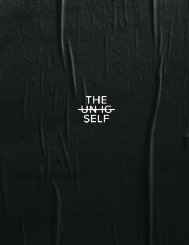Chip Thomas: The Good Fight
You also want an ePaper? Increase the reach of your titles
YUMPU automatically turns print PDFs into web optimized ePapers that Google loves.
PUTTING INTERIORS ON EXTERIORS
To truly excel at one activity is an accomplishment for
anyone. Some people, however, dedicate their lives to
approaching the world from several different angles.
Chip Thomas is a superlative example of the latter.
ARTICLE BY AMELIA RINA | JULY 19, 2018
After narrowly escaping a
youth spent in military
school, Thomas went to a
Quaker Junior High School in the
North Carolina mountains. This
early exposure to pacifist thinking
stayed with him through his years in
medical school, punctuated by trips
to New York City to experience the
’80s street-art scene, and his eventual
medical residency on the Navajo Nation.
Now having lived there for over
three decades, Thomas combines
the healing drive of his medical
practice with the creative force of
his art to produce large-scale wheatpaste
photographic installations on
buildings throughout the reservation
and cities across the United States.
The images feature local people,
many of whom face economic hardship
and social prejudice. Thomas’s
installations act as a tribute to the
local culture and a defiant declaration
that the resilient community
deserves respect and visibility.
- Amelia Rina
Can you talk a bit about your
background and how you ended
up on the Navajo Nation working
with the local community?
I finished medical school in 1983,
which the federal government paid
for through a program called the
National Health Service Corps. At
the end of my training I had a fouryear
obligation to pay the government
back with time, as opposed
to money, and I chose to do time
here on the Navajo Nation about
two hours north of Flagstaff, AZ.
Was photography your first
entry point into your art
practice? When did you start
making photographs?
I’m not formally trained. I’m from
North Carolina originally, and I was
going to start junior high school in
1969, the same year the public school
system desegregated. My parents
were concerned about the amount
of violence that I would face, and I
ended up attending a small Quaker
junior high school. I first used
a darkroom and a camera at that
school when I was about thirteen.
When I came to the Navajo Nation,
it occurred to me that I had never
taken the time to study photography.
I knew what I liked and the
style that I gravitated to, so with
the help of photographer friends in
Flagstaff, I started teaching myself
darkroom techniques. I built
a darkroom my first year here in
’87, and as frequently as possible I
would go out into the community
and attempt to shoot in a documentary
style, telling people’s stories.
15





